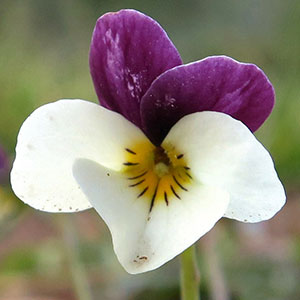Viola hallii
Viola lanceolata
Hall's violet, Oregon violet, wild pansy
bog white violet, Howell's violet, lance-leaf or bog white violet, lance-leaf violet, strap-leaf violet, violette lancéolée, white bog violet
1–3, decumbent or ascending to erect, ca. 1/2 subterranean, glabrous, clustered on single, short, vertical, deep-seated caudex.
basal and cauline;
basal: 1–4, palmately compound, ± 2-ternate or 3-ternate, leaflets 3;
stipules adnate to petiole, forming 2 linear-lanceolate wings, unlobed, margins entire, apex of each wing free, acute;
petiole 5–8 cm, glabrous;
blade ovate to deltate, 2.8–6 × 2.6–6.5 cm, ± coriaceous, base tapered, ultimate lobes narrowly elliptic, lanceolate, or oblanceolate, 1–7 mm wide, margins entire, ciliate or eciliate, apex acute, mucronulate, surfaces glabrous;
cauline similar to basal except: stipules usually lanceolate, sometimes broadly ovate, ± leaflike, margins toothed;
petiole 1.3–6 cm;
blade 2–4.8 × 1.2–5.5 cm.
basal, 2–6(–9), ascending to erect;
stipules linear-lanceolate, margins entire or irregularly lacerate (at least distally), apex acute;
petiole 2–12 cm, glabrous or pubescent;
blade unlobed, lanceolate or narrowly elliptic to nearly linear, 2.5–12 × 0.7–2.5 cm, longer than wide, base attenuate, margins serrate, mostly eciliate, apex acute, mucronulate, surfaces glabrous.
2.5–11 cm, glabrous.
2–17 cm, usually pubescent.
sepals lanceolate to ovate, margins ciliate, auricles 0.5–1 mm;
petals: upper 2 almost black abaxially, dark reddish violet adaxially, lower 3 pale yellow, cream, or ± white, lateral 2 bearded, with deep yellow to orange patch basally, dark reddish violet-veined, lowest with deep yellow to orange patch basally, dark reddish violet-veined, 5–18 mm, spur yellow, gibbous, 0.5–2 mm;
style head bearded; cleistogamous flowers absent.
sepals ovate to lanceolate, margins mostly eciliate, auricles 1–2 mm;
petals white on both surfaces, lowest and sometimes lateral 2 purple-veined, lateral 2 sparsely bearded or beardless, lowest 7–12 mm, spur white, gibbous, 1–2 mm;
style head beardless; cleistogamous flowers on prostrate to ascending peduncles.
ellipsoid, 4–12 mm, glabrous.
ellipsoid, 5–8 mm, glabrous.
light brown, shiny, 3.2–3.5 mm.
beige to bronze, 1.5–2.5 mm.
= 60, 72.
= 24.
Viola hallii
Viola lanceolata
Viola hallii was discovered on the grounds of Willamette University in Salem, Oregon, by Elihu Hall, a professor at that institution (V. B. Baird 1942). Leaves of V. hallii are similar to V. beckwithii.
(Discussion copyrighted by Flora of North America; reprinted with permission.)
Viola lanceolata occurs in small colonies; individual plants are interconnected by stolons.
Viola lanceolata subsp. vittata was recognized by N. H. Russell (1955) based on its linear leaf blade shape. The range in leaf blade shape appears to have no distinct line of demarcation. Some believe that leaf shape differences and near restriction to the coastal plain support recognition at some level. Studies are necessary to resolve this issue.
J. H. Shultze (1946) reported that Viola lanceolata was introduced into Washington in the early 1900s primarily from Cape Cod and Wisconsin as a result of importation of cranberry vines. In British Columbia, it is known from Lulu Island, where it was introduced from eastern North America (G. W. Douglas et al. 1998–2002, vol. 5).
Viola lanceolata reportedly hybridizes with V. primulifolia var. primulifolia (= V. ×modesta House) and V. macloskeyi (= V. ×sublanceolata House).
(Discussion copyrighted by Flora of North America; reprinted with permission.)
- Local floras:
BC,
OR,
WA
- Local Web sites:
Flora NW,
Go Botany,
IL Wildflowers,
LA Plants,
MD Biodiversity,
MI Flora,
MN Wildflowers,
MO Plants,
PNW Herbaria
WildflowerSearch
iNaturalist (observations)
USDA Plants Database
- LBJ Wildflower Center
- SEINet
- Plants of the World Online
- Encyclopedia of Life
- Wikipedia
- Google Image Search


